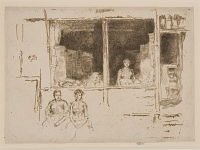Melon Shop, Houndsditch | ||
| Number: | 355 | |
| Date: | 1887 | |
| Medium: | etching and drypoint | |
| Size: | 128 x 178 mm | |
| Signed: | butterfly at left | |
| Inscribed: | no | |
| Set/Publication: | no | |
| No. of States: | 5 | |
| Known impressions: | 10 | |
| Catalogues: | K.293; M.288 | |
| Impressions taken from this plate (10) | ||
KEYWORD
fruit, icebox, interior, man seated, shop-front, window, woman seated, worker.
TITLE
There are occasional differences in spelling, giving variations on the basic title, as follows:
'Mellon Shop' [sic] (1887/1888, Whistler). 2
'Melon Shop, Houndsditch' (1898, Wunderlich's). 3
'Marchand de melons. Houndsditch' (1905, Paris). 4
'Melon-Shop, Houndsditch' (1909, Howard Mansfield (1849-1938)). 5
'Melon-Shop, Hounsditch' (1910, Edward Guthrie Kennedy (1849-1932)). 6
'Melon Shop, Houndsditch' is the preferred title.
'Houndsditch' was and is the most common spelling, although the shorter form of 'Hounsditch' is often used. Miller in 1852, for instance, records, 'we turned up Houndsditch, and visited the real Rag Fair,' and Greenwood in 1867 described the 'Houndsditch Sunday Fair.' 7
'Mellon Shop' [sic] (1887/1888, Whistler). 2
'Melon Shop, Houndsditch' (1898, Wunderlich's). 3
'Marchand de melons. Houndsditch' (1905, Paris). 4
'Melon-Shop, Houndsditch' (1909, Howard Mansfield (1849-1938)). 5
'Melon-Shop, Hounsditch' (1910, Edward Guthrie Kennedy (1849-1932)). 6
'Melon Shop, Houndsditch' is the preferred title.
'Houndsditch' was and is the most common spelling, although the shorter form of 'Hounsditch' is often used. Miller in 1852, for instance, records, 'we turned up Houndsditch, and visited the real Rag Fair,' and Greenwood in 1867 described the 'Houndsditch Sunday Fair.' 7
2: List, [1887/1888], GUW #13233.
3: New York 1898 (cat. no. 192).
4: Paris Mem. 1905 (cat. no. 419).
5: Mansfield 1909[more] (cat. no. 288).
6: Kennedy 1910[more] (cat. no. 293).
7: Thomas Miller, Picturesque Sketches of London, London 1852; James Greenwood, Journeys; or Byways of the Modern Babylon, London, 1867.
DESCRIPTION
The facade of a shop is drawn parallel to the edges of the plate. At front left a middle-aged woman and a young woman sit on a bench, in front of the shop, which has two large open windows. Inside, an old man sits by the window on the left, and two young women stand looking out of the one on the right. To right of the window, steps lead to a narrow open doorway, where an open ice-box is visible.
SITE
Houndsditch is in the East End of London. Whistler was attracted to Houndsditch with its small shops and busy markets, and etched a series of subjects there, the 'Houndsditch Set'. St James's Place housed the premises of several grocers, fruit salesmen and merchants (Jacobs, Levy, Goldsmid, Woolf, Mordecai were among the Jewish tradesmen and women working there). 8 Whistler is known to have made two etchings there, St James's Place, Houndsditch 255 and Nut Shop, St James's Place, Houndsditch 356.
8: London Postal directories, 1880-1888.
DISCUSSION
This is one of many shops etched, drawn and painted by Whistler. In fact it is typical of these compositions, with the rectangular fašade parallel to the edge of the plate, creating a geometrical framework for the shop-girls, goods for sale, and clients. In its depiction of women of different ages it is comparable to After the Sale, Clothes Exchange, Houndsditch 357. However, in this case, Whistler changed the image as he went on to make the shop-girls, who were undoubtedly drawn from life, into more youthful and attractive figures. This is a very sympathetic image of beauty in the back streets. However, it is not clear if all this work was done on site, or if it was revised in the studio from other models.
